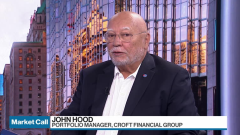Jun 18, 2024
Treasury Yields Slide as Weak Retail Sales Show Fragile Consumer
, Bloomberg News

(Bloomberg) -- US Treasuries rallied, pushing yields to fresh session lows, as investors embraced a sale of 20-year bonds and built up expectations for Federal Reserve interest-rate cuts this year.
Yields declined across the maturity spectrum on Tuesday, with the market extending a rally sparked by weak US retail sales data earlier in the session. The move was led by the two-year yield, which at one point fell nearly 8 basis points below 4.69% — short of last week’s low 4.65%.
A $13 billion auction of 20-year Treasuries, meanwhile, came in well below its pre-sale indicative level, a sign of stronger-than-expected demand.
While the 20-year auction had been seen in the market as a test for investor appetite at lower yield levels, it drew a yield of 4.452% versus a pre-auction yield of around 4.48%. That solid result followed last week’s sales of 10-, and 30-year Treasuries that arrived at lower yields than indicated at the 1 p.m. New York time deadlines.
Here’s what Bloomberg strategists say...
Tuesday’s sale “perhaps speaks to a growing desire to accumulate duration on the part of investors, particularly after the strong demand for 10- and 30-year paper at last week’s auctions.”
“It sure looks like bond investors may be starting to think about more strategic length in duration.”
— Bloomberg Macro Strategist Cameron Crise
Such strong demand for the 20-year bond comes just hours after May retail sales came in weaker than economists estimated, and April figures were downwardly revised. That report had offered the latest evidence of emerging consumer fatigue that has helped Treasuries rally in recent sessions. US industrial production, meanwhile, increased in May.
Yields for most tenors reached the lowest levels since early April on Friday. Meanwhile, JPMorgan Chase & Co.’s Treasury client survey for the week through June 17 showed the most outright longs since June 3.
The market-implied odds of a quarter-point rate cut by the Fed at its September meeting edged up to around 68%. A cut is fully priced in for November, and 48 basis points of easing is anticipated by year-end.
“This may suggest the consumer is beginning to spend less, but be sure, they are still spending,” said Lindsay Rosner, head of multi-sector fixed income investing at Goldman Sachs Asset Management, referring to the data. “There are definitely paths to cut in September.”
Bond investors have been grappling this year with the US economy’s resilience despite 11 Fed rate increases over the past two years, aimed at squelching inflation. While inflation has slowed, progress toward the central bank’s 2% long-term target has stalled, and early expectations for at least six quarter-point rate cuts this year have gradually fallen away.
“The economy has been slowing with inflation in tow,” said Gregory Faranello, head of US rates trading and strategy for AmeriVet Securities. “Ultimately, the data will drive the Fed, and we like the lower rate story here in US Treasuries.”
Favorable inflation data for May released last week partially restored wagers on Fed easing, but other indicators suggest there’s no urgency. May employment data released June 7 showed persistently strong job creation, the S&P 500 and Nasdaq 100 US equity benchmarks are at record high levels, and companies are issuing bonds at a brisk pace.
A slew of Fed officials also added to market sentiment. New York Fed President John Williams said the US economy is “moving in the right direction,” but declined to say when he would favor an interest-rate decrease. Richmond Fed President Thomas Barkin said this month’s inflation figures were “very encouraging.”
Boston Fed President Susan Collins was more cautious and warned of not overreacting “to a month or two of promising news,” while St. Louis Fed President Alberto Musalem said it’s more likely to take “quarters” to see data to support a reduction.
Fed Governor Adriana Kugler said it will likely be appropriate for the central bank to lower interest rates later this year, and Dallas Fed President Lorie Logan said monetary policy was in a good position for patience.
Corporate new-issue volume has exceeded dealers’ expectations every month this year, and stood near $60 billion in June through Monday, versus a full-month forecast for $90 billion. A $21 billion borrowing binge by 13 borrowers on Monday was set to be followed by around 10 offerings Tuesday.
--With assistance from Ye Xie.
(Adds auction results, Fed speakers.)
©2024 Bloomberg L.P.






